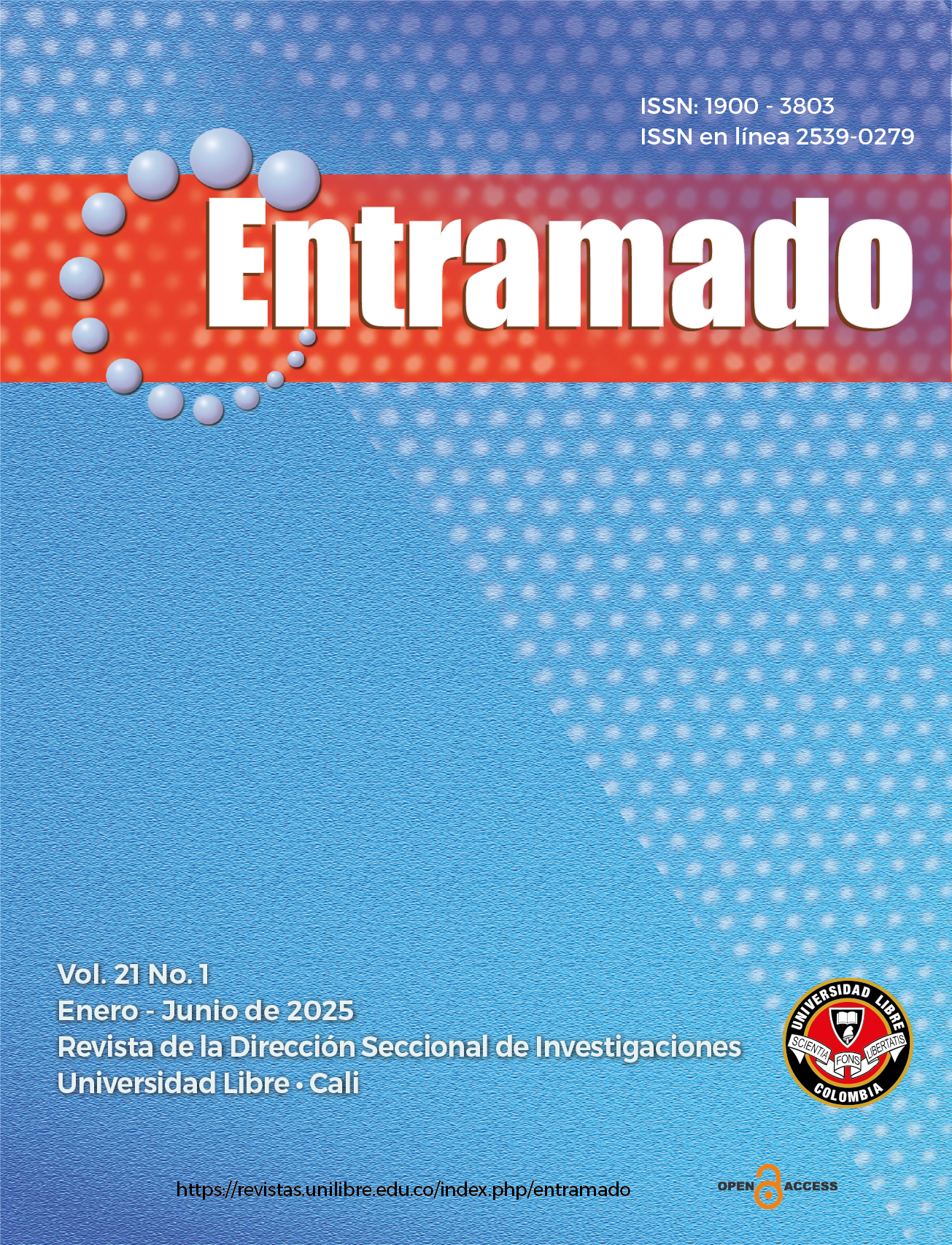Inclusión financiera digital en América Latina: una aplicación de modelos de clasificación
DOI:
https://doi.org/10.18041/1900-3803/entramado.1.12332Palabras clave:
Inclusión financiera, América Latina, Árboles de clasificaciónResumen
La inclusión financiera digital es crucial para el desarrollo económico y social en América Latina, donde el acceso a servicios financieros básicos es limitado y la informalidad en la economía se ha resistido a disminuir. Este trabajo utiliza una metodología novedosa para clasificar a los individuos según tengan o no una cuenta móvil (también conocida como monedero electrónico) en función de sus características socioeconómicas, la tenencia de otros instrumentos y el país de origen entre cuatro naciones latinoamericanas (Argentina, Brasil, Colombia y Perú) en 2021. Las cuentas móviles fomentan el crecimiento inclusivo y reducen los costes de transacción y las limitaciones geográficas, y fueron impulsadas en la era posterior a la pandemia. El objetivo es identificar los atributos más relevantes de la titularidad de cuentas móviles, con el fin de mejorar la inclusión financiera digital. Para la clasificación, los resultados destacan la edad y los ingresos como relevantes pero también poseer una tarjeta de débito, acceder a Internet en casa y haber ahorrado en el último año como factores significativos dejando atrás el país de origen (lo que significa que son muy parecidos) o atributos típicamente relevantes para las finanzas tradicionales como la educación o el género.
Descargas
Referencias
1. AGUFA, Midika Michelle. The Effect of Digital Finance on Financial Inclusion in The Banking Industry in Kenya. Doctoral dissertation, University Of Nairobi, Nov. 2016. https://erepository.uonbi.ac.ke/handle/11295/98616
2. AZIZ, Abdul; NAIMA, Umma. Rethinking digital financial inclusion: Evidence from Bangladesh. In: Technology in Society, 2021, vol. 64, p. 101509. https://doi.org/10.1016/j.techsoc.2020.101509
3. BASTANTE, Marcelo. Estudio Fintech 2020. In: Banco Interamericano de Desarrollo. Ecosistema Argentino. Julio 2020. https://marcelobastante.com/wp/wp-content/uploads/2020/12/Estudio-Fintech-2020-Ecosistema-Argentino.pdf
4. BREIMAN, Leo; FRIEDMAN, Jerome; OLSHEN, R. A.; STONE, Charles J. Classification and regression trees. New York: Routledge.1984 https://doi.org/10.1201/9781315139470
5. CANTÚ, Carlos; ULLOA, Bárbara. The dawn of fintech in Latin America: landscape, prospects and challenges. Bank for International Settlements Papers. 2020. N. 112. https://www.bis.org/publ/bppdf/bispap112.htm?
6. DURICA, Marek; FRNDA, Jaroslav; SVABOVA, Lucia. Decision tree based model of business failure prediction for Polish companies. In: Oeconomia Copernicana, 2019, vol. 10, no 3, p. 453-469. https://doi.org/10.24136/oc.2019.022
7. ENIF. Estrategia Nacional de Inclusión Financiera. Ministerio de la Nación. Argentina 220. https://www.argentina.gob.ar/sites/default/files/enif_2020-23_vf _011220_con_prologo_1.pdf
8. FUNGÁČOVÁ, Zuzana; WEILL, Laurent. Understanding financial inclusion in China. In: China Economic Review. July 2015. vol. 34. p. 196-206. https://doi.org/10.1016/j.chieco.2014.12.004
9. GOMBER, Peter; KOCH, Jasha-Alexander; SIERING, Michael. Digital Finance and FinTech: current research and future research directions. In: Journal of Business Economics. 2017 vol. 8. p. 537-580. https://doi.org/10.1007/s11573-017-0852-x
10. IOANNOU, Stefanos; WÓJCIK, Dariusz. The limits to FinTech unveiled by the financial geography of Latin America. In: Geoforum, 2022, vol. 128, p. 57-67. https://www.sciencedirect.com/science/article/pii/S0016718521003183
11. JAMES, Garet; WITTEN, Daniela; HASTIE, Trevor; TIBSHIRANI, Robert. An Introduction to Statistical Learning: with Applications in R. New York: Springer. 2021. https://www.stat.berkeley.edu/~rabbee/s154/ISLR_First_Printing.pdf
12. KLING, Gerhard; Pesqué-Cela, Vanesa; Tian, Lihui.; Luo, Deming. A theory of financial inclusion and income inequality. In: The European Journal of Finance, 2022, vol. 28, no 1, p. 137-157. https://doi.org/10.1080/1351847X.2020.1792960
13. LEVINE, Mr Ross. Finance, growth, and inequality. International Monetary Fund. 2021. https://www.imf.org/-/media/Files/Publications/WP/2021/English/wpiea2021164-print-pdf.ashx/1000
14. LIN, Wei-Chao; KE, Shih-Wen; TSAI, Chih-Fong. Top 10 data mining techniques in business applications: a brief survey. In: Kybernetes, 2017, vol. 46, no 7, p. 1158-1170. https://doi.org/10.1108/k-10-2016-0302
15. MARTINEZ, Lisana Belén; SCHERGER, Valeria; GUERCIO, María Belén;ORAZI , Sofia. Evolution of financial inclusion in Latin America. In: Academia Revista Latinoamericana de Administración. 2020. vol. 33, no 2, p. 261-276. https://www.emerald.com/insight/content/doi/10.1108/arla-12-2018-0287/full/html
16. ORAZI, Sofía; MARTINEZ, Lisana Belén; VIGIER, Hernan Pedro. Determinants and evolution of financial inclusion in Latin America: A demand side analysis. In: Quantitative Finance and Economics, vol. 7. No 2, 187-206. https://doi.org/10.3934/QFE.2023010
17. OZILI, Peterson K. Impact of digital finance on financial inclusion and stability. In: Borsa Istanbul Review, 2018, vol. 18, no 4, p. 329-340. https://doi.org/10.1016/j.bir.2017.12.003
18. PARVIN, S. R.; PANAKAJE, Niyaz. A study on the prospects and challenges of digital financial Inclusion. In: Education (IJCSBE), 2022, vol. 6, no 2, p. 469-480. https://doi.org/10.5281/zenodo.7259013
19. PIOTROWSKA, Adrianna. Determinants of consumer adoption of biometric technologies in mobile financial applications. In: Economics and Business Review, 2024, vol. 10, no 1, p. 81-100. https://www.ceeol.com/search/article-detail?id=1239518
20. PRUSAK, Błażej. Review of research into enterprise bankruptcy prediction in selected central and eastern European countries. In: International Journal of Financial Studies, 2018, vol. 6, no 3, p. 60. https://doi.org/10.3390/ijfs6030060
21. SHARMA, Anupama; KUKREJA, Sumota. An analytical study: Relevance of financial inclusion for developing nations. In: International journal of engineering and science. 2013. vol.2 no.6. p.15-20. https://www.scirp.org/reference/referencespapers?referenceid=2755643
22. SIMPLICE, Asongu Anutechia; BIEKPE, Nicolas; CASSIMON, Danny. On the diffusion of mobile phone innovations for financial inclusion. In: Technology in Society. 2021. vol. 65, 101542. https://doi.org/10.1016/j.techsoc.2021.101542
23. TAY, Lee-Ying; TAI, Hen-Toong; TAN, Gek-Siang. Digital financial inclusion: A gateway to sustainable development. In: Heliyon, 2022, vol. 8, no 6. https://doi.org/10.1016/j.heliyon.2022.e09766
24. TRAM, Thi Xuan Huong; LAI, Tien Dinh; NGUYEN, Thi Truc Huong. Constructing a composite financial inclusion index for developing economies. In: The Quarterly Review of economics and finance, 2023, vol. 87, p. 257-265. https://doi.org/10.1016/j.qref.2021.01.003
25. World Bank, Digital Financial Inclusion, 2021. https://www.worldbank.org/en/topic/financialinclusion/publication/digital-financial-inclusion
26. YANGDOL, Rigzin; SARMA, Mandira. Demand-side factors for financial inclusion: A cross-country empirical analysis. In: International Studies, 2019, vol. 56, no 2-3, p. 163-185. https://doi.org/10.1177/0020881719849246
27. ZINS, Alexandra; WEILL, Laurent. The determinants of financial inclusion in Africa. In: Review of development finance, 2016, vol. 6, no 1, p. 46-57. https://hdl.handle.net/10520/EJC193922
Descargas
Publicado
Número
Sección
Licencia
Derechos de autor 2025 Entramado

Esta obra está bajo una licencia internacional Creative Commons Atribución-NoComercial-CompartirIgual 4.0.


